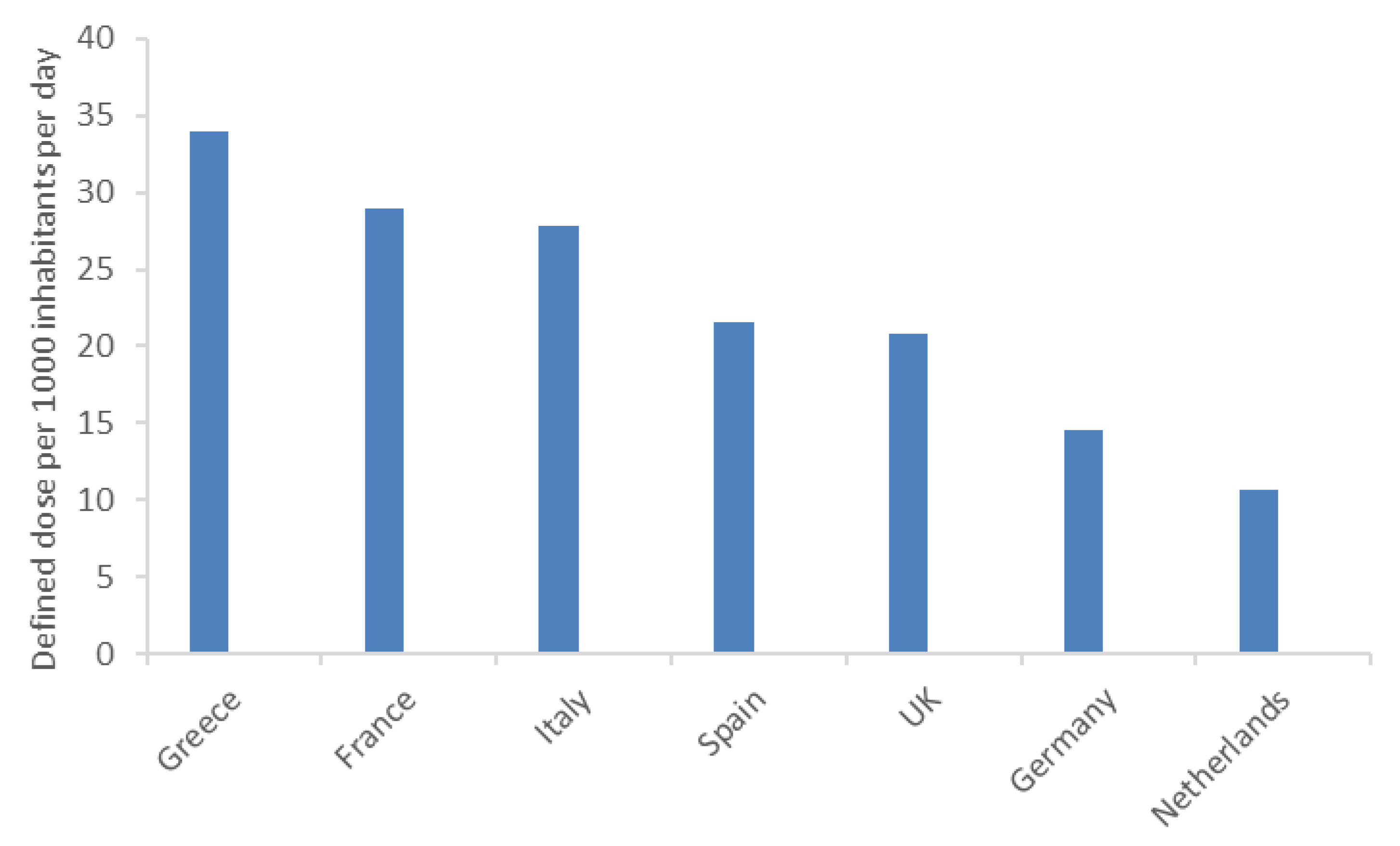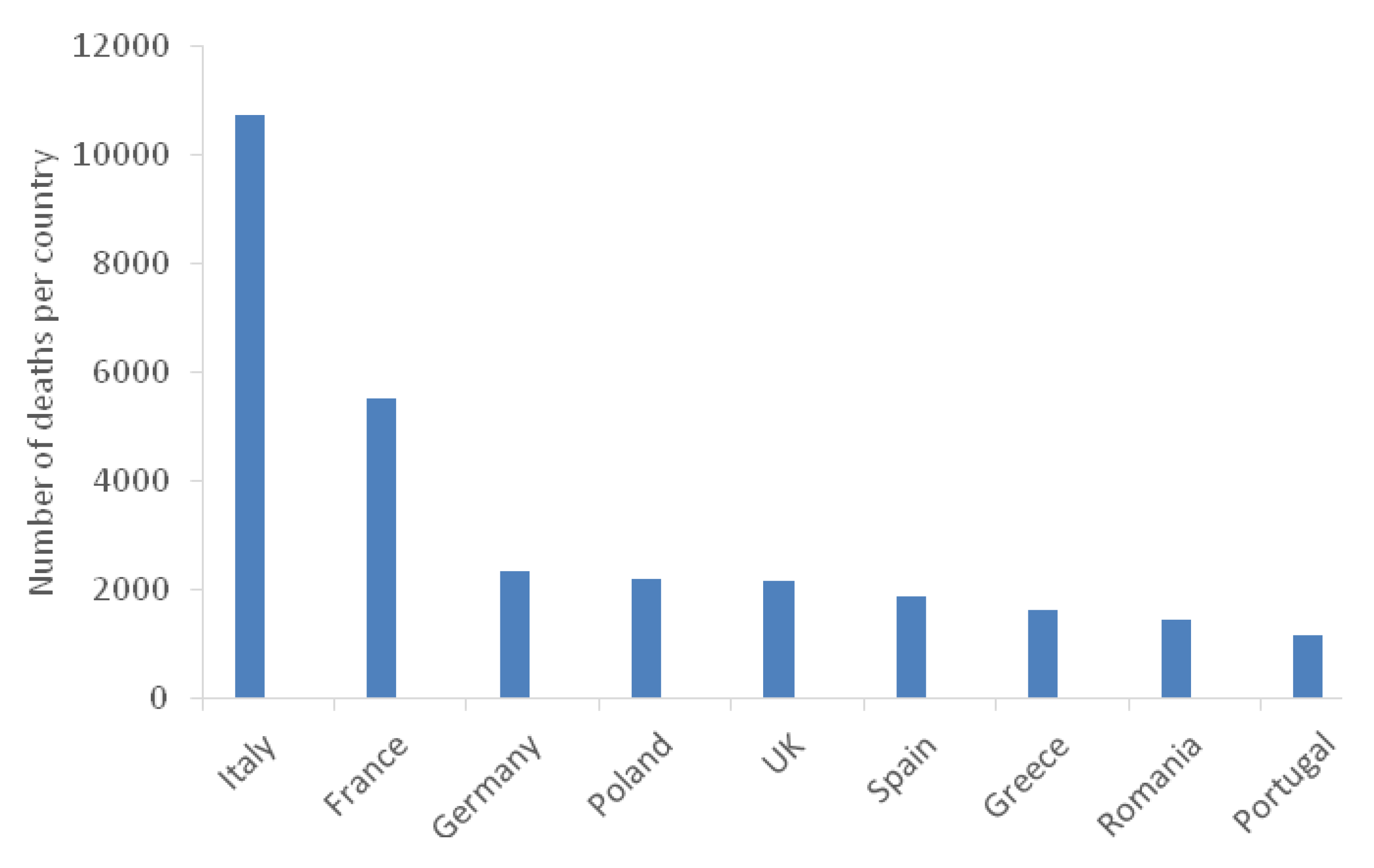Humans, Animals, Food and Environment: One Health Approach against Global Antimicrobial Resistance
Abstract
:Author Contributions
Funding
Conflicts of Interest
References
- Van Boeckel, T.P.; Gandra, S.; Ashok, A.; Caudron, Q.; Grenfell, B.T.; Levin, S.A.; Laxminarayan, R. Global antibiotic consumption 2000 to 2010: An analysis of national pharmaceutical sales data. Lancet Infect. Dis. 2014, 14, 742–750. [Google Scholar] [CrossRef]
- Klein, E.Y.; Van Boeckel, T.P.; Martinez, E.M.; Pant, S.; Gandra, S.; Levin, S.A.; Goossens, H.; Laxminarayan, R. Global increase and geographic convergence in antibiotic consumption between 2000 and 2015. Proc. Natl. Acad. Sci. USA 2018, 115, E3463–E3470. [Google Scholar] [CrossRef] [PubMed] [Green Version]
- Van Boeckel, T.P.; Brower, C.; Gilbert, M.; Grenfell, B.T.; Levin, S.A.; Robinson, T.P.; Teillant, A.; Laxminarayan, R. Global trends in antimicrobial use in food animals. Proc. Natl. Acad. Sci. USA 2015, 112, 5649–5654. [Google Scholar] [CrossRef] [PubMed] [Green Version]
- EU Health Ministerial Meeting—Health Ministerial Meeting—Next Steps towards Making the EU a Best Practice Region in Combating AMR, Bucharest, Romania, March 1, 2019. Available online: https://www.oecd.org/health/antimicrobial-resistance.htm (accessed on 8 May 2020).
- World Health Organization. Antimicrobial Resistance. Global Report on Surveillance. 2014. Available online: https://apps.who.int/iris/bitstream/handle/10665/112642/9789241564748_eng.pdf;jsessionid=A429AB84C7418DF4FDC8D52318842658?sequence=1 (accessed on 1 May 2020).
- European Food Safety Authority and European Centre for Disease Prevention and Control. The European Union Summary Report on Antimicrobial Resistance in zoonotic and indicator bacteria from humans, animals and food in 2017/2018. EFSA J. 2020, 18, e06007. [Google Scholar]
- European Medicines Agency. Sales of Veterinary Antimicrobial Agents in 31 European Countries in 2017. 2017. Available online: https://www.ema.europa.eu/en/documents/report/sales-veterinary-antimicrobial-agents-31-european-countries-2017_en.pdf (accessed on 4 May 2020).
- Silver, L.L. Challenges of antibacterial discovery. Clin. Microbiol. Rev. 2011, 24, 71–109. [Google Scholar] [CrossRef] [PubMed] [Green Version]
- Abedini, A.; Colin, M.; Hubert, J.; Charpentier, E.; Angelis, A.; Bounasri, H.; Bertaux, B.; Kotland, A.; Reffuveille, F.; Nuzillard, J.M.; et al. Abundant extractable metabolites from temperate tree barks: The specific antimicrobial activity of Prunus avium extracts. Antibiotics 2020, 9, 111. [Google Scholar] [CrossRef] [PubMed] [Green Version]
- Rodrigues Costa, A.; Bezerra, J.W.A.; Pereira da Cruz, R.; de Freitas, M.A.; da Silva, V.B.; Neto, J.C.; dos Santos, A.T.L.; Bezerra Morais Braga, M.F.; da Silva, L.A.; Ivaneide Rocha, M.; et al. In vitro antibiotic and modulatory activity of Mesosphaerum suaveolens (L.) Kuntze against Candida strains. Antibiotics 2020, 9, 46. [Google Scholar] [CrossRef] [PubMed] [Green Version]
- Pereira da Cruz, R.; Sampaio de Freitas, T.; do Socorro Costa, M.; Lucas dos Santos, A.T.; Ferreira Campina, F.; Pereira, R.L.S.; Bezerra, J.W.A.; Quintans-Júnior, L.J.; De Souza Araújo, A.A.; De Siqueira Júnior, J.P.; et al. Effect of α-bisabolol and its β-cyclodextrin complex as TetK and NorA efflux pump inhibitors in Staphylococcus aureus strains. Antibiotics 2020, 9, 28. [Google Scholar] [CrossRef] [PubMed] [Green Version]
- De Araújo, A.C.J.; Freitas, P.R.; Rodrigues dos Santos Barbosa, C.; Muniz, D.F.; Esmeraldo Rocha, J.; Neto, J.B.A.; da Silva, M.M.C.; Moura, T.F.; Pereira, R.L.S.; Ribeiro-Filho, J.; et al. Essential oil of Croton ceanothifolius Baill. potentiates the effect of antibiotics against multiresistant bacteria. Antibiotics 2020, 9, 27. [Google Scholar] [CrossRef] [PubMed] [Green Version]
- Macedo da Silva, R.O.; Gonçalves Castro, J.W.; de Menezes Dantas Junior, O.; Justino de Araújo, A.C.; do Nascimento Silva Leandro, M.K.; Oliveira Costa, R.J.; Leite Pinto, L.; Garcia Leandro, L.M.; Silva, L.E.; do Amaral, W.; et al. Photoinduced antibacterial activity of the essential oils from Eugenia brasiliensis Lam. and Piper mosenii C. DC. by blue led light. Antibiotics 2019, 8, 242. [Google Scholar] [CrossRef] [PubMed] [Green Version]
- Thassya Lucas dos Santos, A.; Pereira Carneiro, J.N.; Pereira da Cruz, R.; Lima Sales, D.; Cosmo Andrade, J.; de Oliveira Almeida, W.; Martins da Costa, J.G.; Riceli Vasconcelos Ribeiro, P.; Sousa de Brito, E.; Alves Batista, F.L.; et al. UPLC-MS-ESI-QTOF analysis and antifungal activity of the Spondias tuberosa Arruda leaf and root hydroalcoholic extracts. Antibiotics 2019, 8, 240. [Google Scholar] [CrossRef] [PubMed] [Green Version]
- Yap, W.F.; Tay, V.; Tan, S.H.; Yow, Y.Y.; Chew, J. Decoding antioxidant and antibacterial potentials of Malaysian green seaweeds: Caulerpa racemosa and Caulerpa lentillifera. Antibiotics 2019, 8, 152. [Google Scholar] [CrossRef] [PubMed] [Green Version]
- European Commission. A European One Health Action Plan against Antimicrobial Resistance (AMR). 2017. Available online: https://ec.europa.eu/health/amr/sites/health/files/antimicrobial_resistance/docs/amr_2017_action-plan.pdf (accessed on 4 May 2020).
- World Health Organization. Global Action Plan on Antimicrobial Resistance. 2015. Available online: https://www.who.int/antimicrobial-resistance/publications/global-action-plan/en/ (accessed on 4 May 2020).
- Aboody, M.S.A.; Mickymaray, S. Anti-fungal efficacy and mechanisms of flavonoids. Antibiotics 2020, 9, 45. [Google Scholar] [CrossRef] [PubMed] [Green Version]


| [1] |
| [2] |
| [3] |
| [3] |
| [4] |
| [4] |
| [4] |
| [4] |
| Bacterium | Resistance/Decreased Susceptibility to |
|---|---|
| Escherichia coli | 3rd generation cephalosporins, fluoroquinolones |
| Klebsiella pneumoniae | 3rd generation cephalosporins, carbapenems |
| Staphylococcus aureus | Methicillin (β-lactam antibiotics) |
| Streptococcus pneumoniae | Penicillins |
| Nontyphoidal Salmonella | Fluoroquinolones |
| Shigella spp. | Fluoroquinolones |
| Neisseria gonorrhoeae | 3rd generation cephalosporins |
| Antibacterial Drug | Year of Discovery |
|---|---|
| Salvarsan | 1908 |
| Penicillin | 1928 |
| Sulfonamide | 1932 |
| Streptomycin | 1943 |
| Bacitracin | 1945 |
| Nitrofurans | 1946 |
| Chloramphenicol, polymyxin | 1947 |
| Chlortetracycline, cephalosporin | 1948 |
| Pleuromutilin | 1950 |
| Erythromycin, isoniazid | 1952 |
| Vancomycin, streptogramin | 1954 |
| Cycloserine | 1955 |
| Novobiocin | 1956 |
| Rifamycin | 1957 |
| Metronidazole | 1959 |
| Nalidixic acid, trimethoprim, lincomycin, fusidic acid | 1961 |
| Fosfomycin | 1969 |
| Mupirocin | 1971 |
| Carbapenem | 1976 |
| Oxazolidinone | 1978 |
| Monobactam | 1981 |
| Daptomycin | 1987 |
| Discovery void | |
| Plant Products | Target Organisms | Notes | References |
|---|---|---|---|
| Prunus avium tree bark methanol extracts | Seventeen Bacterial and five yeast strains | Antibiofilm activity against Staphylococcus aureus; dihydrowogonin was the most active constituent | [9] |
| Mesosphaerum suaveolens aqueous extracts (in combination with fluconazole) | Candida strains | The extract potentiated the antifungal drug | [10] |
| α-Bisabolol (in combination with tetracycline and norfloxacin) | S. aureus strains | The compounds potentiated the antibiotics inhibiting the bacterial efflux pumps | [11] |
| Croton ceanothifolius essential oil (EO) (in combination with penicillin, norfloxacin and gentamicin) | S. aureus, Pseudomonas aeruginosa and Escherichia coli multiresistant strains | The combination exhibited a synergistic effect | [12] |
| Eugenia brasiliensis and Piper mosenii EOs (in association with blue led light and aminoglycosides) | S. aureus and E. coli strains | The association of EOs with the blue LED light increased the activity of amikacin and gentamicin | [13] |
| Spondias tuberosa hydroalcoholic extracts (in combination with fluconazole) | Candida strains | Synergism with the fungicide | [14] |
| Caulerpa racemosa and Caulerpa lentillifera chloroform, methanol and aqueous extracts | Methicillin-resistant S. aureus and neuropathogenic E. coli | Candida racemosa chloroform extract showed the highest antibacterial activity | [15] |
© 2020 by the authors. Licensee MDPI, Basel, Switzerland. This article is an open access article distributed under the terms and conditions of the Creative Commons Attribution (CC BY) license (http://creativecommons.org/licenses/by/4.0/).
Share and Cite
Iriti, M.; Vitalini, S.; Varoni, E.M. Humans, Animals, Food and Environment: One Health Approach against Global Antimicrobial Resistance. Antibiotics 2020, 9, 346. https://doi.org/10.3390/antibiotics9060346
Iriti M, Vitalini S, Varoni EM. Humans, Animals, Food and Environment: One Health Approach against Global Antimicrobial Resistance. Antibiotics. 2020; 9(6):346. https://doi.org/10.3390/antibiotics9060346
Chicago/Turabian StyleIriti, Marcello, Sara Vitalini, and Elena Maria Varoni. 2020. "Humans, Animals, Food and Environment: One Health Approach against Global Antimicrobial Resistance" Antibiotics 9, no. 6: 346. https://doi.org/10.3390/antibiotics9060346
APA StyleIriti, M., Vitalini, S., & Varoni, E. M. (2020). Humans, Animals, Food and Environment: One Health Approach against Global Antimicrobial Resistance. Antibiotics, 9(6), 346. https://doi.org/10.3390/antibiotics9060346







